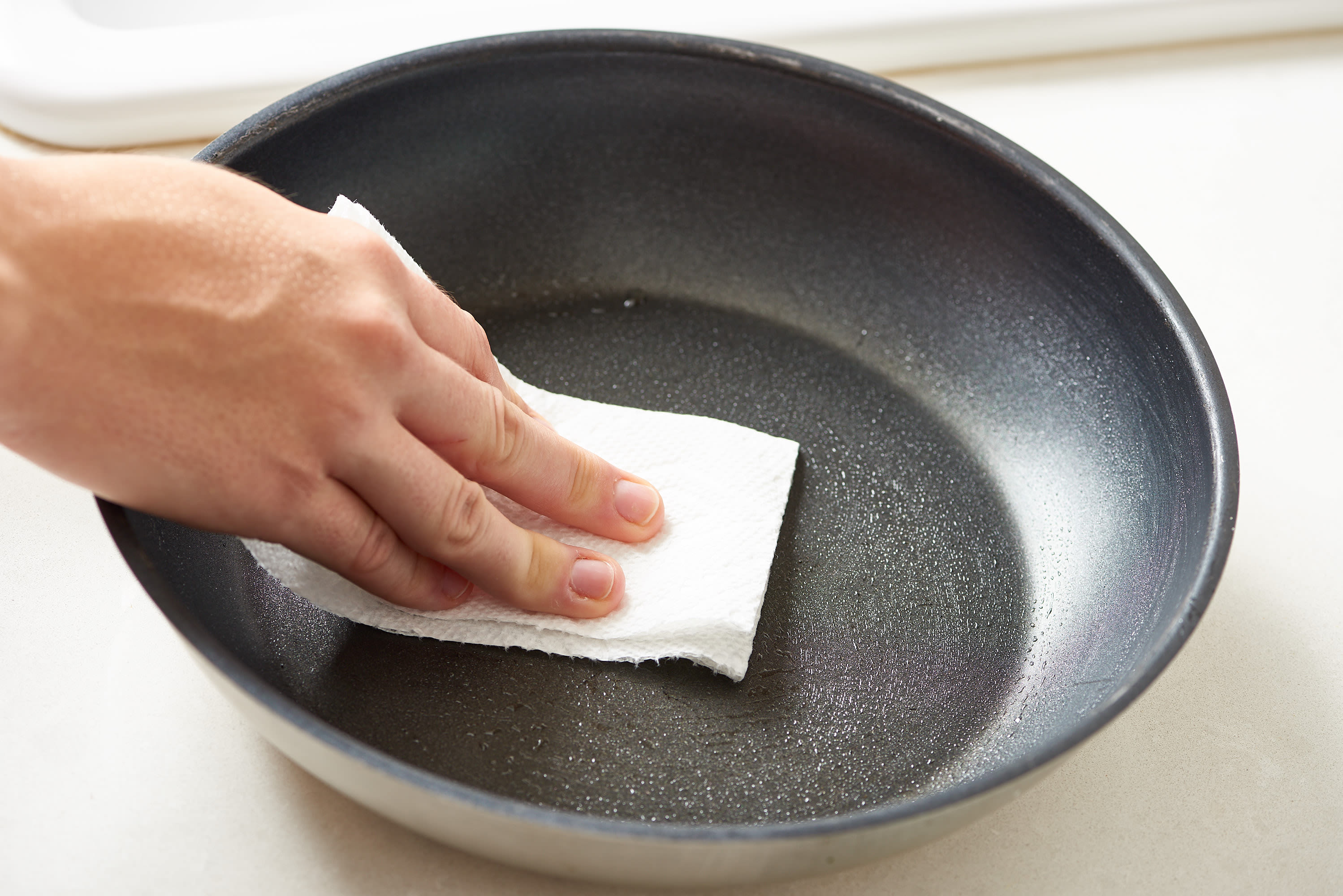Bleaching cookware is possible, but it requires caution. Always check the manufacturer’s guidelines before proceeding.
Can You Bleach Cookware:Cookware comes in various materials, each with its own cleaning needs. While stainless steel can often handle bleach, non-stick, aluminum, and copper pots and pans might not. The trick to maintaining your kitchen essentials lies in understanding the right cleaning techniques.
Bleaching can disinfect and whiten, but it’s a harsh chemical that could damage some surfaces. Before you reach for the bleach, consider the cookware’s material and the type of residue you’re dealing with. Opt for gentler alternatives if your items are not compatible with bleach. Proper care ensures your cookware stays in top condition, ready for your next culinary adventure. Remember, the goal is to extend the life of your kitchen investments while keeping them sparkling clean.

Credit: www.reddit.com
The Risks Of Bleaching Cookware
Cleaning cookware is important for hygiene. Yet, using bleach poses risks. Understanding these risks helps ensure safe kitchen practices. Let’s explore the dangers of bleaching cookware.
Chemical Reactions With Materials
Bleach is harsh. It can react with cookware materials. This may damage the cookware. For example:
- Metals like aluminum and stainless steel can corrode.
- Non-stick coatings might peel off.
- Ceramics could get discolored.
Such damage not only ruins cookware but also makes it unsafe for cooking.
Potential Health Hazards
Bleach contains chemicals that are dangerous if ingested.
Improper rinsing can leave residue. This residue may mix with food. It can lead to health issues like:
- Nausea
- Vomiting
- Stomach pain
Long-term exposure is even more harmful. It could cause serious health problems.
Types Of Cookware And Bleach Compatibility
Choosing the right cleaning method for cookware is key. Bleach offers powerful disinfection. Yet, not all materials handle bleach well. We’ll explore which cookware types mix with bleach.
Stainless Steel And Bleach Interactions
Stainless steel is durable. It can tolerate mild bleach solutions. Use bleach sparingly on stainless steel. Rinse thoroughly after.
Non-stick Surfaces And Bleach
Bleach harms non-stick coatings. It can degrade the surface. Avoid using bleach on non-stick pots and pans.
Cast Iron And Bleach: A Bad Mix
Cast iron needs gentle care. Bleach causes rust and strips seasoning. Keep bleach away from cast iron cookware.
Alternatives To Bleach For Cookware Cleaning
Seeking alternatives to bleach for cookware cleaning is wise. Bleach can be harsh. It may not be the best choice for all cookware materials. Non-toxic and gentle options exist. They can effectively clean without damaging surfaces.
Natural Cleaning Agents
Natural cleaners offer safe and eco-friendly options. These cleaners are gentle on cookware. They can handle tough stains and odors.
- Vinegar: Cuts through grease.
- Baking soda: Scrubs away tough residue.
- Lemon juice: Fresh scent and antibacterial.
- Salt: For scouring cast iron.
Combine these ingredients for enhanced cleaning power. They are readily available. They are affordable.
Specialized Cookware Cleaners
Specialized cleaners target specific cookware needs. They are formulated for different materials. They ensure longevity and shine.
| Cookware Type | Cleaner Type | Benefits |
|---|---|---|
| Stainless Steel | Non-abrasive cream | Prevents scratching |
| Non-stick | Soft foam cleaner | Preserves coating |
| Cast Iron | Oil-based conditioner | Builds seasoning |
| Copper | Mild acidic solution | Restores shine |
Choose cleaners designed for your cookware. Follow manufacturer instructions for best results. This maintains performance and appearance.
:strip_icc()/JF_HowtoCleanStainless-SteelPans-Primary-2333-a48111a5f66743258d00fd8172b32cac.jpg)
Credit: www.bhg.com
Understanding Bleach Concentrations
When cleaning cookware, knowing bleach concentrations is key. Bleach is a powerful disinfectant. It’s vital to use it safely to avoid damage to your cookware and potential health risks. Let’s dive into how to properly dilute and apply bleach.
Dilution Ratios For Safe Use
The right dilution ensures safety and effectiveness. Use the following guidelines:
- Standard cleaning: Mix 1 tablespoon of bleach with 1 gallon of water.
- Sanitizing: Use 1 teaspoon of bleach per 1 quart of water.
- Heavy-duty tasks: A stronger mix may be necessary. Consult product instructions.
Always wear gloves and ensure good ventilation.
Reading Labels For Proper Application
Every bleach bottle has a label. Read it carefully for:
| Label Section | Details to Note |
|---|---|
| Concentration | Usually ranges from 5-8% sodium hypochlorite. |
| Usage Instructions | Follow for safety and efficiency. |
| Safety Warnings | Includes necessary precautions. |
Match the right bleach type with your cookware material.
The Right Way To Use Bleach On Cookware
Cleaning cookware is essential for kitchen hygiene. Sometimes, regular soap won’t do. Bleach can be effective for sanitizing cookware. It kills germs and removes stains. But it’s important to use it correctly to avoid damage.
Step-by-step Bleaching Process
- Dilute the bleach with water. Use one tablespoon of bleach per gallon of water.
- Submerge your cookware completely. Ensure the solution covers all surfaces.
- Soak for at least 5 minutes. This kills bacteria and loosens stains.
- Rinse thoroughly with water. Do this immediately after soaking.
- Dry the cookware completely. Use a clean, dry towel or air-dry.
Precautions To Take
- Wear gloves to protect your hands from the bleach.
- Never mix bleach with other cleaners. Toxic fumes can result.
- Use in a well-ventilated area to avoid inhaling fumes.
- Test on a small area first. This checks for any adverse reactions.
- Follow the manufacturer’s instructions on your cookware. Some materials may not be bleach-safe.
Long-term Effects Of Bleach On Cookware
Using bleach on cookware might seem like a good idea. It kills germs and makes pots shine. But, bleach can harm your cookware over time. Let’s explore how.
Corrosion And Wear
Bleach is harsh and can damage cookware materials. Stainless steel, aluminum, and non-stick surfaces can all suffer. Bleach causes corrosion and wear, leading to pits and scratches.
- Stainless steel can get rusty spots.
- Aluminum may become dull and discolored.
- Non-stick coatings can peel off, making them unsafe.
Impact On Cookware Lifespan
Using bleach shortens your cookware’s life. Healthy cookware turns unsafe and unusable faster. This means you have to buy new pots and pans more often.
| Cookware Type | Without Bleach | With Bleach |
|---|---|---|
| Stainless Steel | 15+ years | 5-10 years |
| Aluminum | 10+ years | 3-5 years |
| Non-stick | 5+ years | <2 years |
Choosing safer cleaning methods protects your cookware. It saves money and keeps cooking safe.
Cleaning Burnt Pots And Pans Without Bleach
Dealing with burnt pots and pans can be tough. You might think bleach is the only way to get them clean. But there are safer, easier methods. Let’s explore how to clean burnt cookware without using bleach.
Effective Methods
Cleaning doesn’t have to be hard. Here are some simple ways to make your pots and pans shine again:
- Boiling Water: Fill the pot with water. Boil it. This helps loosen the burnt parts.
- Vinegar and Baking Soda: Mix equal parts. Boil in the pot. It lifts the burnt stuff.
- Salt Scrub: Salt acts like a gentle scrubber. It’s great for surfaces.
Home Remedies
Some things in your kitchen can clean too. Here are a few:
- Lemon and Baking Soda: Cut a lemon in half. Sprinkle baking soda on the cut side. Scrub the pot with it. Rinse well.
- Potato and Dish Soap: Cut a potato in half. Dip it in dish soap. Scrub your pot. This works wonders.
- Tomato Sauce: Acid in tomatoes fights stains. Boil tomato sauce in your pot. It cleans it.
These methods are safe and use things you likely have at home. Try them next time you face burnt cookware!
Maintaining Cookware Post-bleaching
After bleaching cookware, proper maintenance is key. It extends the life and performance of your pots and pans. Follow these tips for the best care post-bleaching.
Rinsing And Drying Best Practices
Bleach residue on cookware can be harmful. Always rinse thoroughly. Use hot water to remove all bleach. Dry your cookware immediately after rinsing. Use a soft towel or a drying rack. This prevents water spots and rust.
- Use hot water for rinsing
- Dry immediately to avoid spots
- Prevent rust and damage
Seasoning Cookware After Bleach Use
Cast iron and some steel cookware need seasoning. It restores the protective layer after bleaching. Use a light coat of cooking oil. Heat the cookware slightly to open the pores. Apply the oil evenly with a clean cloth. Bake in the oven or heat on the stove. This creates a non-stick surface.
- Heat cookware to open pores
- Apply a thin layer of oil
- Bake or heat to season
Expert Opinions On Bleaching Cookware
Many wonder about the safety and effects of bleaching cookware. Experts share insights on this practice. Let’s explore what professionals suggest regarding the use of bleach on cookware.
Chef Recommendations
Chefs stress caution when considering bleach for cleaning cookware. Here are their key points:
- Avoid bleach on non-stick surfaces. It can damage the coating.
- Stainless steel may withstand light bleaching for tough stains.
- Use bleach only as a last resort and dilute it properly.
- Rinse cookware thoroughly after bleaching to remove all residues.
Manufacturer Guidelines
Manufacturers provide specific advice for their products. Here’s a summary:
| Material | Guideline |
|---|---|
| Stainless Steel | Diluted bleach is okay for occasional use. |
| Aluminum | Avoid bleach; it can cause corrosion. |
| Ceramic | Bleach may be safe but check with the brand. |
| Non-Stick | Do not use bleach; it damages the surface. |
Always refer to the care instructions provided with your cookware. When in doubt, contact the manufacturer.
Safe Cookware Cleaning For Health And Environment
Safe Cookware Cleaning for Health and Environment is a topic of growing importance. Clean cookware is essential for healthy cooking. Yet, many cleaning products harm our planet. Can we bleach our pots and pans without guilt? Let’s explore eco-friendly and health-conscious ways to maintain our cookware.
Eco-friendly Cleaning Solutions
Going green with cleaning routines is a smart choice. Natural ingredients can work wonders. They keep our earth safe. Here are some top eco-friendly cleaners:
- Baking soda – a gentle, effective scrub
- Vinegar – cuts through grease naturally
- Lemon juice – shines and disinfects
- Castile soap – a plant-based cleaner for all surfaces
Create your mix or use these solo. Your cookware will thank you.
Protecting Your Family’s Health
Clean cookware is a health shield for your family. Chemical residues from harsh cleaners can linger. They may mix with your food. This is not good for anyone.
Choose safe, non-toxic methods for peace of mind:
- Use hot water for daily cleaning.
- Scrub with natural materials like bamboo or copper.
- For tough stains, soak in diluted vinegar before scrubbing.
Small steps can make a big difference. Keep your cookware clean and your family healthy.

Credit: www.thekitchn.com
Frequently Asked Questions
Will Bleach Ruin A Nonstick Pan?
Using bleach on a nonstick pan can damage the coating and is not recommended. Stick to gentle cleaners for these pans to maintain their nonstick surface.
Can I Bleach My Pans?
Yes, you can bleach pans, but ensure the material is bleach-safe, dilute it properly, and rinse thoroughly after bleaching. Always follow the manufacturer’s instructions.
Is It Okay To Bleach Dishes?
Bleaching dishes is safe if you dilute the bleach properly and rinse the dishes thoroughly after disinfecting. Always use bleach in a well-ventilated area.
Does Bleach Ruin Stainless Steel Pots?
Bleach can damage stainless steel pots by causing pitting and corrosion if used improperly or left on the surface for extended periods. Rinse thoroughly after use.
Conclusion
To sum up, bleaching cookware requires caution but is achievable with the right approach. Remember to use gentle bleach solutions and rinse thoroughly. Embrace these tips, and your kitchenware will sparkle safely. Keep your meals and cookware in top shape!





Leave a Reply